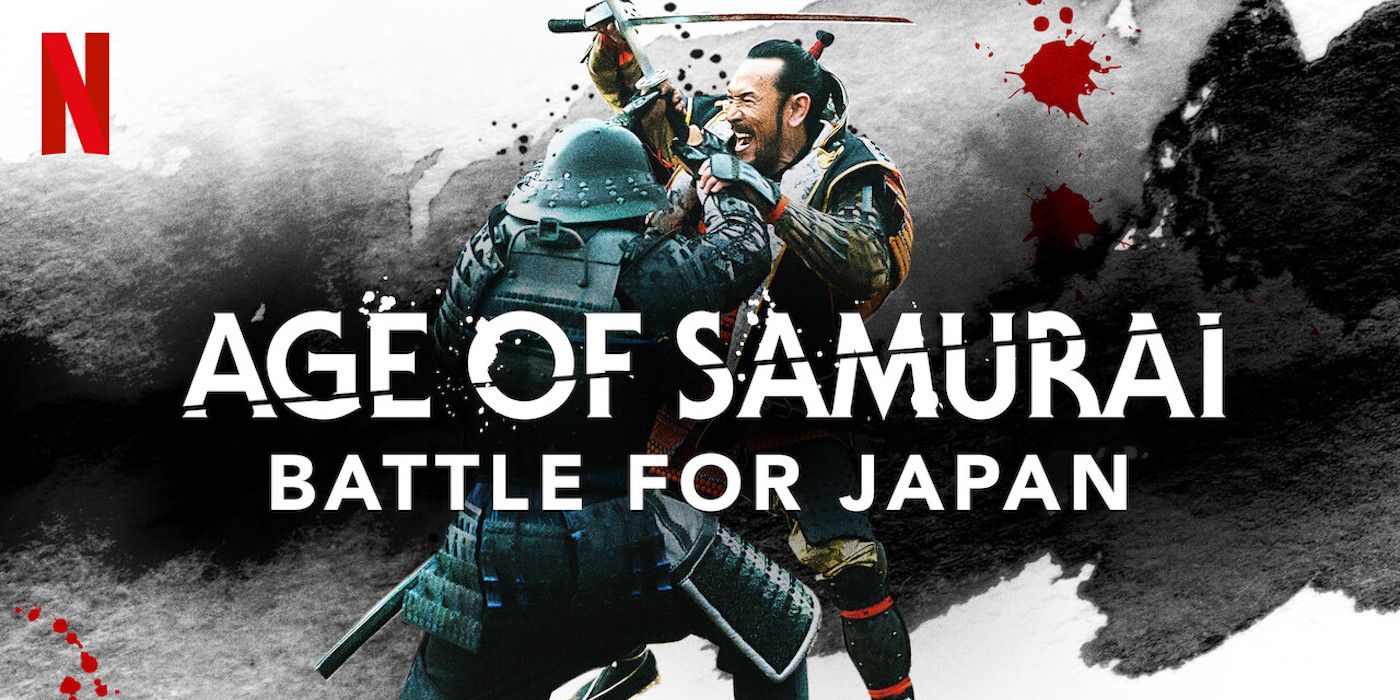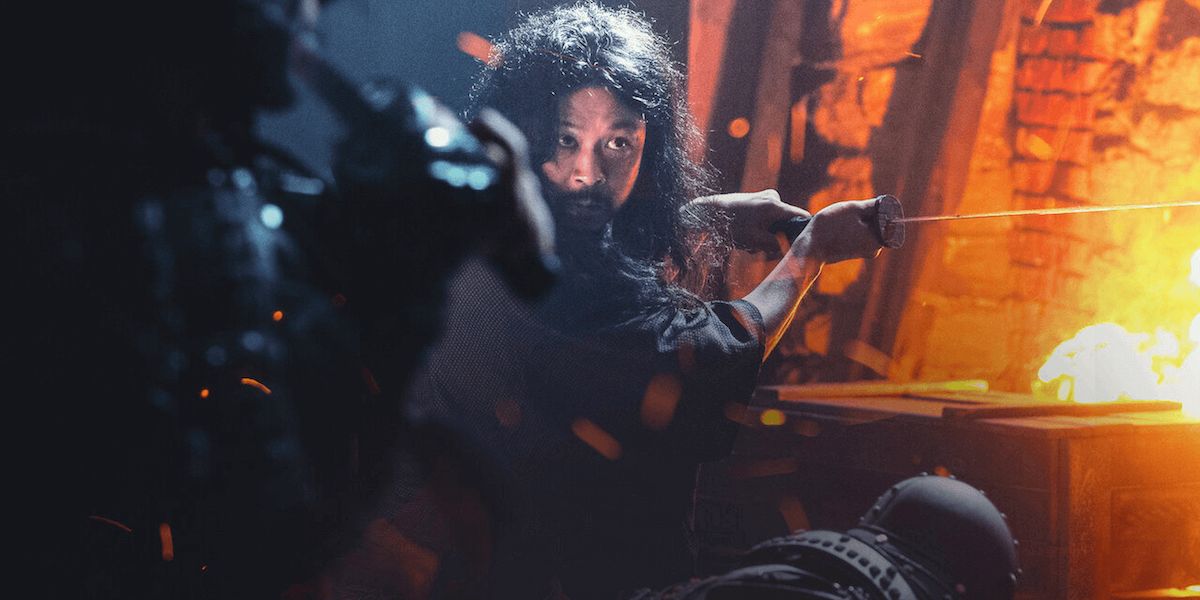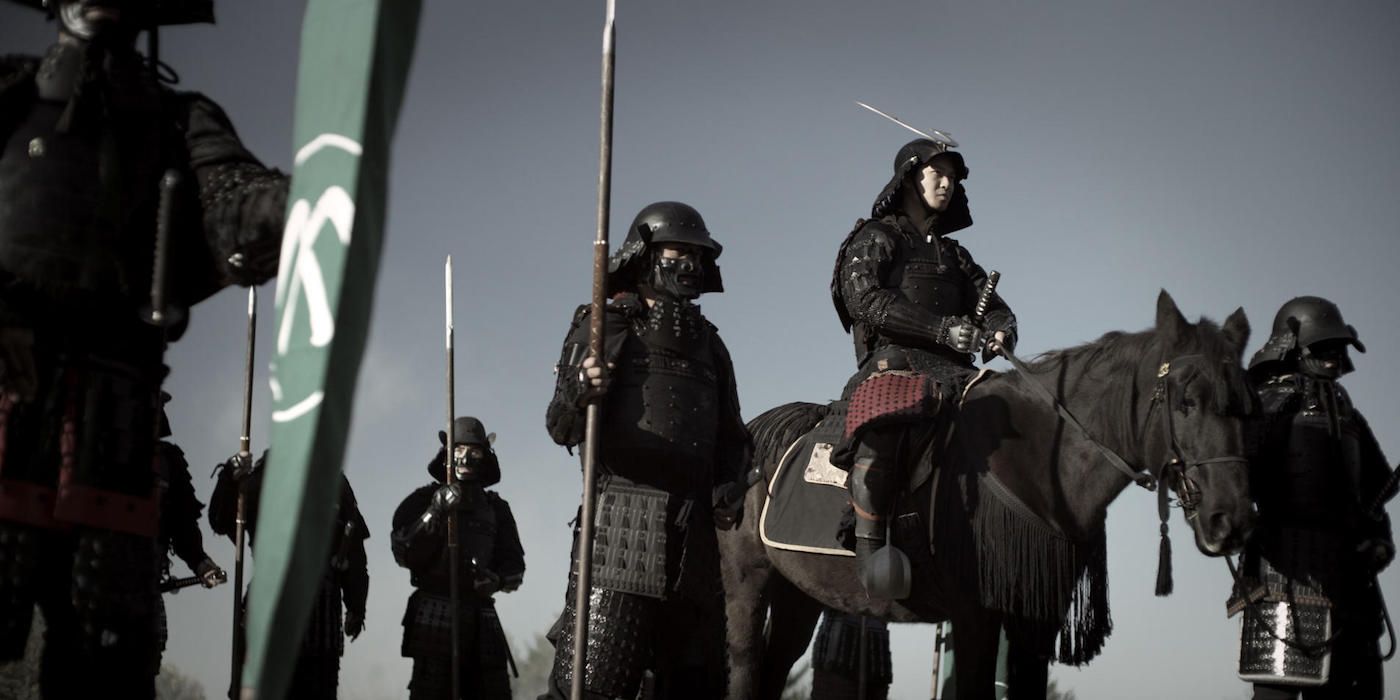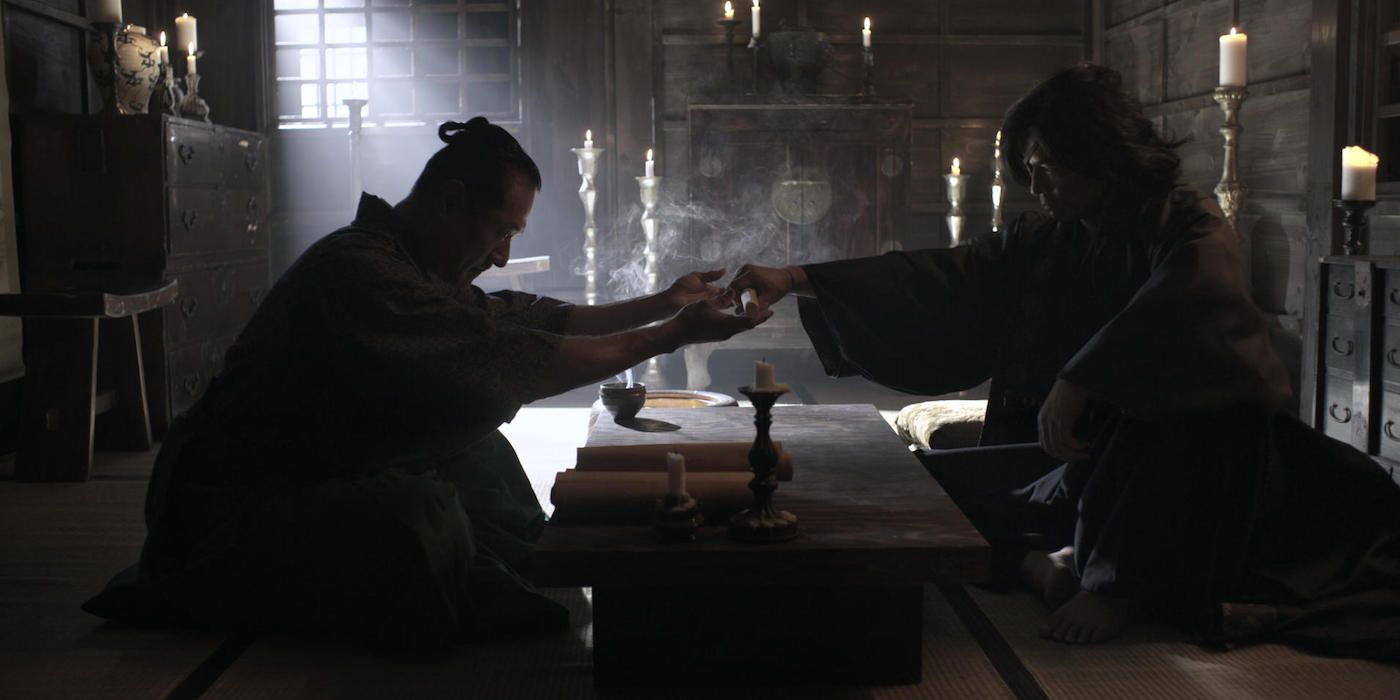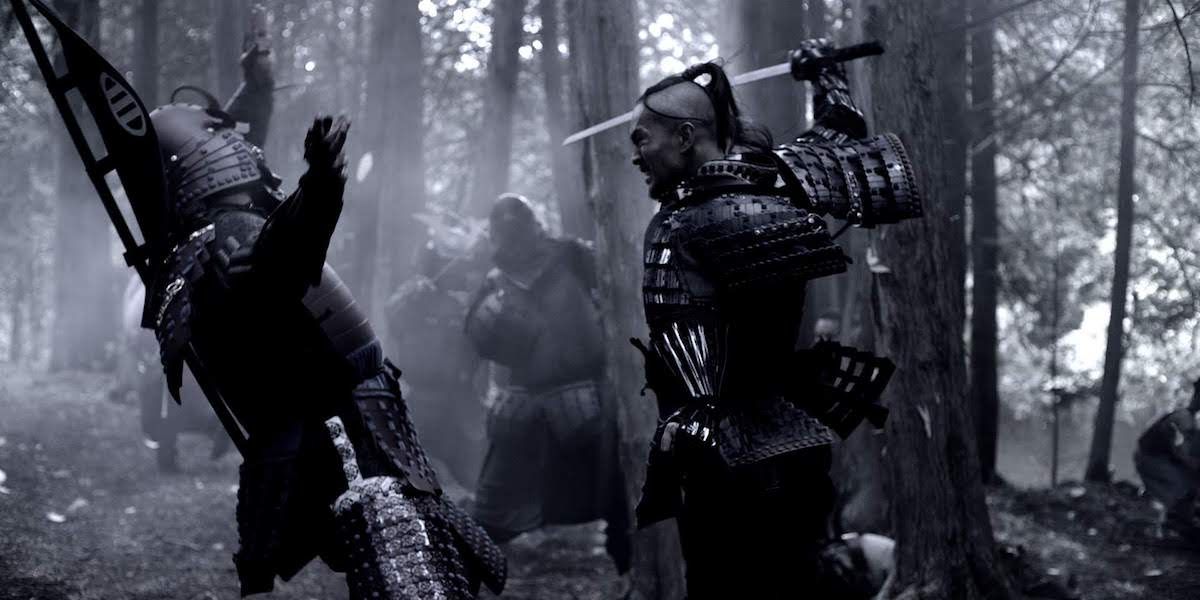The samurai of feudal Japan nurture an evergreen fascination among historians and curious passersby alike. The juxtaposition of honor and violence has tickled the imaginations of millions, and countless films, books, video games, and novels have explored every facet of samurai culture and the ever-changing code of honor called Bushido. Now, a new Netflix docu-drama series aims to capture the brutal magic of the Sengoku Jidai period.
Age of Samurai: Battle for Japan tells the story of three families fighting for control of Japan during one of the most violent eras in human history. Though based on historical fact, the series is presented with dramatic flair and a focus on graphic novel-style visual storytelling. Basically, it's not a traditional documentary with talking heads and endless exposition, but a realistic snapshot of carnage and conquest, told over six parts.
While promoting the release of Age of Samurai: Battle for Japan on Netflix, showrunner Matthew Booi spoke to Screen Rant about his work on this new type of docu-series. He explains why samurai of this particular chapter of feudal Japan's long history are so particularly fascinating, and who it was so important for him to be as historically accurate as possible while remaining stylish and entertaining to audiences across all levels of scholastic interest. To that end, he emphasizes the importance of filling all the main roles with Japanese actors speaking their native language, as well as focusing on a very specific group of characters, to tell their story with a cinematic grandeur rarely seen in the docu-drama genre.
Age of Samurai: Battle for Japan is out now on Netflix.
Tell me about what got you interested in samurai, was it something you saw on TV, something you learned in school?
When you hear the word samurai, for most of us, they're the most iconic, ferocious warrior out there. Even more than the knights of the crusades and whatnot. When it comes to pure heavy hitters, I think few figures loom as large in our historical imagination than the samurai. For me, I'll be honest, I think my first exposure came from Shogun, the Richard Chamberlain miniseries, when I was a little kid. It just stuck in my head after that. I was always really fascinated with the period and with the role they played. I think there's such a fascinating mix of violence and honor and duty. I think they're really unique in history, in that sense, and that's why there's always a fascination with them.
I don't know if it's a male thing or a lizard brain thing, but maybe that's the same thing, of that juxtaposition of honor and violence. They were as ruthless as anyone could imagine, and maybe that's why this series needs to have real Hollywood-style production values in its dramatic reenactments of real moments.
I think it just lends itself so well to scope and scale. Obviously, we're walking in the footsteps of some of the greats, whether it's Kurosawa or whomever. I think there's something so cinematic and powerful and visual about them. It's the swords, it's the armor, the banners. There's something so powerfully visual about it. And you can read about it, and it's so compelling, but to see them, I think it's such an incredibly powerful visual thing. It's something we went into this with from the very beginning. We were inspired by graphic novels and the history of graphic storytelling in Japan. When you look at the composition, our color correction, even our costumes, it's all designed to look like a graphic novel, even how it's framed. It has a desaturated look but with these violent pops of color with the blood, the ink, the armor. The red of our main samurai's armor, those things pop. As filmmakers, it was such a wonderful world to explore because it is so visual.
For the show, tell me about straddling that line between getting to be fanciful, if that's the word, and being a straightforward documentary. When did you go, "Okay, we can make this as cool as we want, even if we're painting outside the lines a little bit."
The beauty of this is, I think you get the best of both worlds when you're dealing with samurai. Because of the nature of the conflict and the way they carried themselves, you have a visual panache that you don't really have to bend truth to get. That's the other thing that's so shocking when you dig into the history, the stories are so powerful, and they're so driven by individuals, and that's what you want as a storyteller! You want stories about people who are changing history, and that's at the very core of our show, and the core of the history of warring states Japan, or the Sengoku Jidai period, as they call it.
Tell me a little bit about the history in terms of who you brought in, and were there people you wanted to bring in to help tell this story?
Obviously, you always rely on your historians for something like this. And we were really fortunate to get who we thought were some of the best names in the business. We went all over the world, talking with Japanese academics, British academics, American academics... We wanted to find the best storytellers, too. We found a remarkable bunch of people. There's almost no narration in the show. We really wanted to let the history speak for itself. We use chapter headings three or four times per show, where we give a 40,000 foot view of what's happening from the big picture, and then we go in and see what's really happening on the ground. We couldn't have done that without the historians that we had. They were an incredible bunch.
There's a tendency for documentaries in general to have a sterile touch about them because they're so macro in their scale that you don't get the chance to see the day-to-day experiences of people living in history. But the sensibilities of such a time are almost unrelatable unless you can see it from a boots-on-the-ground perspective. And it looks like this show aims to say, "This is what it was like."
You nailed it on the head, Zak, you really did. The biggest challenge filmmakers have when telling big-picture history is, how do you avoid chronology? Chronology isn't entertaining. What is entertaining is active protagonists trying to achieve goals. We were really lucky with this story. We really focused on three individuals who completely changed the course of Japanese history. We felt it was essential to get down to the ground and try to tell these stories on the ground. What's so incredible about these stories is how you're reminded constantly of how similar we are to the people of this period. But there are certain things about the samurai culture that really are unique. For example, they had something called a head viewing ceremony; after a massive battle, the winning general would sit and be presented with the heads of all the fallen soldiers from the other side. These heads would be painted, make-up would be put on them. It would be kind of garish. On one hand, it was kind of humiliation for the fallen, but on the other hand, it was a way of honoring those men who lost their lives. Again, it's an incredible thing about the period. A mix of unbelievable violence with incredible honor and duty. You see it with the Seppuku, which is ritual suicide. There's a number of them in the show, where people get into positions where they cannot honorably defend themselves. So instead of running and fleeing like the vast majority of us would do, they sit down and the ritually kill themselves And we've seen this in other cultures, but the degree to which it's practiced in this period is remarkable. The obsession with honor and with legacy. I think it's quite remarkable.
I'm thinking about the sheer brutality juxtaposed against the honor and civilization... Every culture across history has had some version of that relationship, but I don't know if anyone did it as stylishly as they did.
It's so true, Zak. The panache of the samurai and their relationship to violence... I think it's important to understand, too, that samurai in the 16th century had no monopoly on violence. The 16th century, as a whole, is probably one of the most violent periods in human history. If you look at it across the globe, you're talking about the Inquisition, and incredibly violent battles that were wracking Europe at the time. Nobody had a monopoly on this. But a strong case could be made that nobody performed it the same way as the Japanese samurai did. It's just such a fascinating story. And I think people are going to be so drawn in by it, the deeper you get into it. I think that was the real beauty of having six hours where we really got to lean into the stories. What we also did to make it easier to track it, despite the fact that we're dealing with almost five decades of history, we're really only focusing on three families that are incredibly interconnected. It becomes almost like a Godfather story, or Game of Thrones, where one of these guys is going to pull it off at the end, but you don't know who. And the one who does pull it off in the end, it's really quite surprising. We've met all these people in the first episode. And over the six episodes, we chart the rise and fall, the fracturing of alliances, and how one of them ultimately pulls it off. I think that part of the storytelling will hopefully really resonate with people. It's not a giant survey at everything that happened. It's really a deep look at the relationships between three families, really.
As such a deep look, is this a setting you'd like to return to again and again, or am I putting the cart before the horse?
Oh, I think this is such a rich world. I think you could mine this world over and over. We're telling three major stories. And what we left of the table was just unbelievable. After all the research we did and hundreds of hours of interviews, we told one tiny fraction of the world of the samurai. We try to tell one story really well. I like to say, we're kind of like the shark's fin. We're not the whole body. If you want that, you have to dig deep into the history and read the 1200 page books. But we'll give you a really good look at one part of the shark, the coolest part of the shark! (Laughs)
Tell me about casting. I imagine you maybe have multiple actors playing the same people in different parts of their life?
Interestingly enough... I don't want to give any spoilers here, but we were able to get a lot of use out of the actors we had because of the way we chose to tell the story. Here's one thing that was really important to us: we wanted it to feel real, feel authentic, so it was essential for us to use Japanese actors speaking Japanese. We knew, for us, it was going to be an absolute deal breaker if, the first time we land in a scene, someone opens their mouth and it's in English. We thought that would be Game Over for us. It was important to have Japanese actors. We brought in wonderful Japanese actors to play all the key roles. And I think it was just such a good decision. It grounds it in a reality that you're not going to get any other way. It means the audience has to do a little work and read subtitles...
Subs over dubs!
I think it's worth it. It was essential for us that Japanese be spoken. I just think you would have bumped so hard, especially after all the work we did with historians to make the world feel real. We just thought it would be a bridge too far for viewers. That said, we tried to make it easier on the viewers in that we tried to tell a lot of the storytelling through action and through powerful visuals, and like a graphic novel, through the images themselves. It's not like something where people are going to have to slog through hours of subtitles. It's not a melodrama. It's still a very fast-driven look at an incredibly violent and exciting period of history. So we definitely kept our audiences in mind when dealing with the subtitles.
Tell me about that graphic novel approach and how that extends to more than really cool action scenes.
When we say we try to adopt a "graphic novel approach," I think that means we try to use that type of visual storytelling to drive our story. We tried to make it as visual as possible. It's about shot composition, the choices we're making in edits, and trying to tell a powerful story through images. That's what graphic novels and great cinema can do. An image can convey something that's powerful and important. There's so much information being thrown at you from our historians. It's a lot of stuff! It's a world we don't know very well. We try, in the visuals, to slow it down and give you a chance to catch your breath and get stuck into the story. So, when we talk about using a graphic novel approach, that's about giving it some time and space to lean in and try to luxuriate in the world.
The costumes look amazing, too.
It was a big deal, trying to get those right. We worked with our costume designer... In some cases, we were lucky enough to get some that had been made for other Japanese productions. In other cases, they were constructed. We approached it from a lot of different angles. Some of them had very specific pieces of armor we wanted them to have. Those had to be custom made. In other cases, we were able to get away with pieces that had been made in Japan for other productions. The focus for us was, first and foremost, telling an incredibly entertaining story that was going to resonate with viewers. That was our driving goal all the time. We are, of course, obsessed with getting the history right and making sure our historians are laying the history out in the right way, but ultimately, we want to tell a great story that's going to draw viewers in. This is not directed to just history buffs. This is directed to people who love a great story. That's ultimately what this is about. It's not a six-hour discussion on the intricacies of Japanese politics and military. It's really about three guys who are trying to do the impossible. Their nation has descended into brutal, all-out civil war being waged by some of the most ferocious fighters of all time, and they're all trying, in their own ways, to bring order to that chaos and become the one person who can rule Japan. That's what this story is about. Bringing order to chaos, and how difficult it was for all of them. That's really the engine driving this. I think people who love a great story are going to be drawn into this, because it's ultimately very personal.

